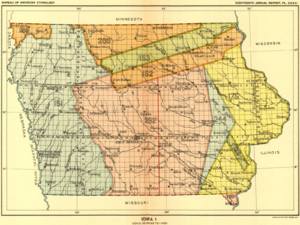Keokuk's Reserve facts for kids
Keokuk's Reserve was a special area of land in what is now the U.S. state of Iowa. This land was set aside for the Sauk and Fox tribes in 1832. This happened after a conflict known as the Black Hawk War. The tribes lived on this reserve for a few years. By 1836, the land was given to the United States government. The Native Americans then moved to a new reservation.
Understanding the Treaty Terms
The treaty that ended the Black Hawk War had important rules. It gave a large part of present-day Iowa to the United States. This area was called the Black Hawk Purchase. Keokuk's Reserve was a smaller piece of land taken from this larger purchase. The treaty said the reserve would include Keokuk's Village. This village was about twelve miles (19 km) from the Mississippi River. The reserve also included equal parts of land on both sides of the Iowa River.
The reserve covered about 400-square-mile (1,000 km2) along the Iowa River. Its boundary crossed the river and went southeast. It ended past Keokuk's Village. The land around the reserve was given to the United States by the Fox and Sauk tribes. This was part of the Black Hawk Purchase agreement.
Life on the Reservation
After the Black Hawk War, the Sauk and Fox people had to move to Keokuk's Reservation. This was part of the treaty they signed. From the start, the land on the reserve did not have many resources. There wasn't much game for hunting.
Between 1833 and 1845, the number of Sauk and Fox people living there went down. The community also faced other difficulties. There were disagreements among the leaders and people.
Giving the Land to the United States
On September 28, 1836, a new treaty was signed. This treaty gave all the land in Keokuk's Reserve to the United States government. The signing took place near Davenport, Iowa. Important people like Henry Dodge were there. More than 1,000 chiefs and warriors from the Sauk and Fox nations also attended. This included the respected leader, Black Hawk. The treaty stated that the Sauk and Fox decided to give up the land to "obtain additional means of support" and "pay their just creditors."
As a result, the Sauk and Fox living in Keokuk's Reserve moved. They went to another reservation along the Des Moines River. An Indian Agency office was set up there. This is where Agency, Iowa is today. The treaty also promised payments to the Sauk and Fox. They would receive US$30,000 in June 1837. They would also get $10,000 each year for the next ten years. The treaty included other payments too. For example, $1,000 went to the widow of Felix St. Vrain. About $48,000 helped the Sauk and Fox pay their debts.
After moving to the new reservation, Joseph M. Street became their agent. He was an agent for the Winnebago before. A farmhouse and two mills were built for the tribes. One mill was destroyed by a flood, but the other lasted for several years. Keokuk and two other chiefs, Wapello and Appanoose, worked on farm fields on the reservation.


